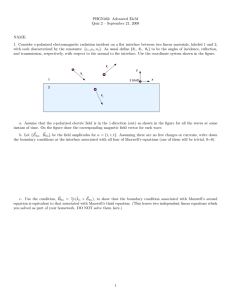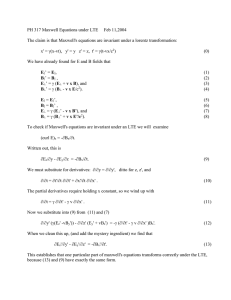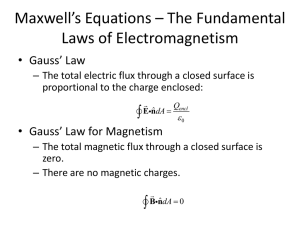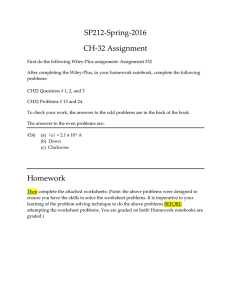8. MAXWELL`S EQUATIONS So far we have seen the four equations
advertisement
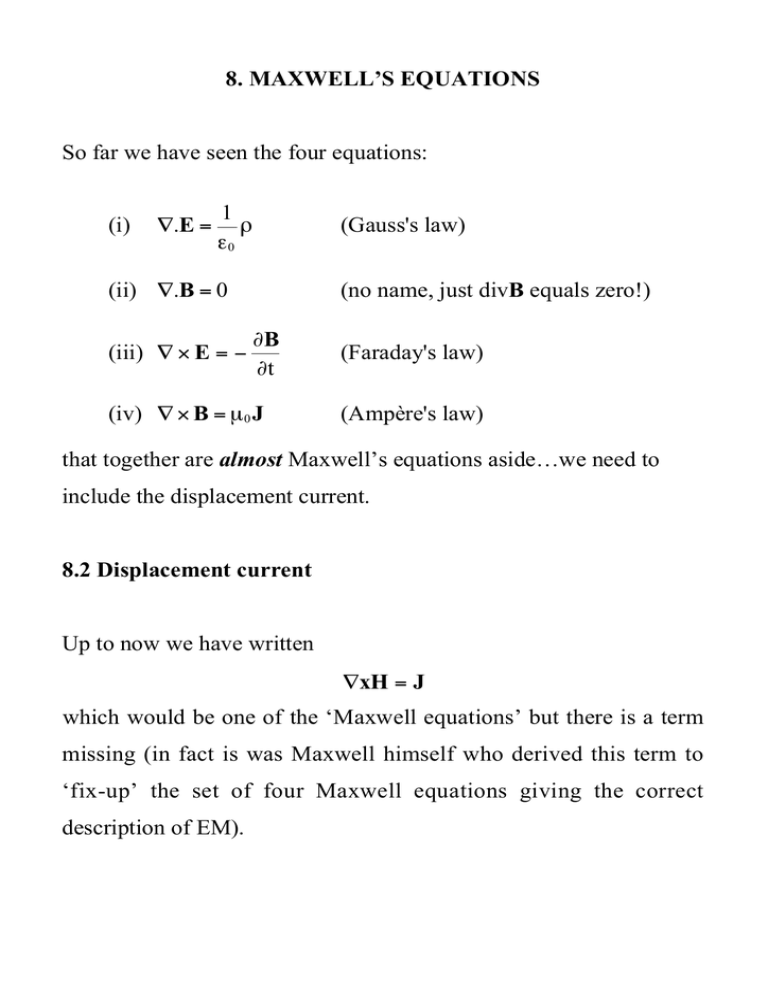
8. MAXWELL’S EQUATIONS So far we have seen the four equations: (i) ∇.E = 1 ρ ε0 (ii) ∇.B = 0 (iii) ∇ × E = − (Gauss's law) (no name, just divB equals zero!) ∂B ∂t (iv) ∇ × B = µ 0 J (Faraday's law) (Ampère's law) that together are almost Maxwell’s equations aside…we need to include the displacement current. 8.2 Displacement current Up to now we have written ∇xH = J which would be one of the ‘Maxwell equations’ but there is a term missing (in fact is was Maxwell himself who derived this term to ‘fix-up’ the set of four Maxwell equations giving the correct description of EM). If we take the divergence of both sides of ∇xH = J we find ∇.(∇xH) = 0 = ∇.J (*) div of curl of any vector field is zero (see vector identity (9) inside front cover of Griffiths) But the Continuity eqn says ∇.J = − ∂ρ ∂t for time-varying fields so (*) cannot be correct in general. To correct things we need to add the time-varying term ∂ρ to the r.h.s of (*): ∂t ∇.(∇xH) = 0 = ∇.J + ∂ρ ∂t and since ∇.D = ρ, ∂D ∇.(∇xH) = 0 = ∇. J + ∂t or, ∇xH = J + ∂D ∂t ‘corrected’ Maxwell equation for curlH The time-varying term ∂D is called the displacement current. ∂t The equation ∇xH = J + ∂D ∂t tells us that there will be a magnetic field (due to the displacement current ∂D ∂t ) even when there is no current flow (i.e. when J = 0 ). We usually write ∇xH = J + ∂D in terms of B and E: ∂t ∇xH = J + ∂D ∂t by recalling B = µ 0 H (free space) and D = ε 0 E (free space) ∇ × B = µ 0 J + µ 0ε 0 ∂E ∂t 8.2 Maxwell’s Equations in differential form We can now write the complete set of Maxwell equations, including the correction term (the displacement current): 1 ρ ε0 (i) ∇.E = (ii) ∇.B = 0 (iii) ∇×E =− (iv) ∇ × B = µ 0 J + µ 0ε 0 (Gauss's law) (no name, just divB equals zero!) ∂B ∂t (Faraday's law) ∂E ∂t (Ampère's law with Maxwell's correction) Eqns (i) – (iv) tell us how CHARGES produce FIELDS and the force equation (electric + magnetic force acting on a moving charge) F = q(E + v x B) tells us how FIELDS affect CHARGES which together with the equation of continuity ∇.J = − ∂ρ ∂t provide all the mathematical apparatus needed to describe electromagnetism – that is to solve all problems in classical electromagnetism on the macroscopic scale. 8.3 Maxwell’s equations in integral form Maxwell’s equations in integral form perhaps give us a greater physical insight: (i) ∫S D.da = Q f ,enc integrate over closed surface S (ii) ∫SB.da = 0 (iii) ∫L E.dl = − d B.da dt ∫S closed loop L bounding surface S (iv) ∫L H.dl = I f ,enc + d D.da dt ∫S 8.4 Visualization of Maxwell’s equations (i) Gauss’ law: ∫S D.da = Q f ,enc or ∫S E.da = Q total ε0 lines of E leaving volume τ through surface S Surface S bounding volume τ Volume τ + + + + + E E Lines of E begin on positive charges. E lines exit enclosing volume τ through surface S. Gauss’ law says the total flux of E leaving enclosed volume τ is equal to the total charge enclosed by surface S divided by ε0. (ii) ∇.B = 0 or ∫SB.da = 0 (differential form) (integral form) S ∫s B.da = 0 or ∇.B = 0 B Lines of magnetic induction B pass through the closed surface S. The net outward flux (divB) through the surface is zero. Gauss divergence theorem states, for any ‘well-behaved’ vector field A, ∫ (∇.A)dτ = ∫ A.da τ integral of divA over the volume τ s integral of flux through surface S enclosing volume τ (iii) Faraday’s law ∫L E.dl = − d B.da dt ∫S open surface S (within loop) fixed in space L The B-field is changing giving a changing flux. In this case B points in direction arrowed and is increasing B The emf induced in the loop L defined on surface S is equal to the rate of change of the magnetic flux through the surface enclosed by L. flux through S ∫L E.dl = − emf in loop ≡ vector integral of electric field around L d B.da ∫ S dt rate of change of magnetic flux through surface defined by loop L Faraday’s law is easy to see (and you’ll recognise it from first year!) if we take a physical (actual) loop (e.g. of wire): Permanent magnet moved into loop of wire ε S ε = − dΦ dt Φ = B.A N galvanometer ε provides a changing magnetic flux (the − d B.da term) generating ∫ S dt an emf in the wire (the ∫LE.dl term; electric field E established the emf) which deflects the galvanometer. (iv) ∫L H.dl = I f ,enc + d J + ∂D .da D. d a = ∫S ∂t dt ∫S or, equivalently, J + ε ∂E .da B. d l = µ 0 0 ∫L ∫S ∂t L J+ ∂D ∂t The term ∫LH.dl is equal to the sum of two contributions linking loop L (i) the free current J, (ii) the displacement current ∂D ∂t The arrows on the diagram above give the direction of the free current J. If D is downward and increasing or upward and decreasing the displacement current J D = ∂D ∂t is also in the downward direction
